-
Content Count
101 -
Joined
-
Last visited
Posts posted by Runarsson
-
-
Best thing to do is try out each vise, take some tying stuff and sit down and tie on one at a fly shop or if know a person who has one. Thats the best way to go. DK is truly built like a tank tho. I use mine when I build bass and muskie stuff since its a big vise and it is solid. Both also been good for customer services except once with DK where I didnt get get an answer but wasnt their fault so.
Amen to that! 'Try and buy'... in that order. I have a bad experience from doing it the other way around... buying before trying. I was going to upgrade from my Danvise and was going between a Barracuda Junior Trekker and a Griffin Montana Mongoose. I had never seen any of them in real life and the word 'Junior' in the name scared me a little. I didn't want a small vise, so finally I ordered the Mongoose. It was the best vise I'd had so far, so in the beginning I thought it was great. But soon I started to dislike it more and more in every way... ergonomics... quality... design. Though I still tied on it for a year, since it had costed me $280 (in Sweden) and I couldn't really justify buying another expensive vise too soon.
The actual width of my mistake was revealed to me when I was invited to Sowbug Roundup 2006 and got to see a Barracuda Junior in real life. Only a quick look made it clear to me which of them actually was the TRUE 'junior'... and after trying it, it also became clear which was the vise FOR ME.
So when I got home my Mongoose was soon replaced and the vises I've had since then have been Barracuda models. But that Mongoose in my drawer will always be a bad memory of wasted money and almost a year of irritation.
'Try and buy'... in that order.
-
While you can tie the smaller hooks on the standard jaws, certainly down to #20, the one feature I do not like about the Dyna-King jaws is if you are not careful, you can crush a hook if you don't get the adjustment right. Hence why I prefer the Renzetti for smaller flies, but they are both fine vises, and I think this is pretty close to an apples vs. oranges sort of decision.
Same here. 'Fine' or 'fine'... but 'this' or 'that'. I have no doubt that they both make top notch vises. Though which of them will be the "best vise" always lies in the eyes of the individual... what he wants and doesn't want from his vise. I have not tried a Renzetti and the only Renzetti cons I have are based on text and pictures (so I'm not 100% that I've gotten everything right).
Renzetti cons (vs. Dyna-King):
* The jaws height adjustment (3-step and with a tool)...
* Expensive jaws and also different for the vise models (I've had three different Barracuda models but only bought midge jaws once)...
* The rotary handle that doesn't allow for a 90 degree handle (after gotten used to having one I wouldn't want to be without it)...
A little con on the Dyna-King rotary vise is that its width sometimes can make it feel a little bit large on the bench. I don't really know the width of the Renzetti pedestal base, but compared to its right end, the jaws on the Renzettis don't look like they reach out very far from the vise stem. It does look a little "neater" in size (and if I'm right about it, it would be a Renzetti pro to me). But it's the only Barracuda "con" I can think of... and since it's not a major one either, a Renzetti would still be a step down on my bench.
-
When I use the whip-finisher I use a cheap Matarelli knock-off. I can't imagine in what way the original would be better.
Mostly use my fingers together with the closed scissors though since I never seem to find the tools on my bench right away. Instead of the top hook on the whip-finisher I use the closed blades on the scissors. But as I almost always have the scissors hidden in my palm while tying I don't have to look for them on the bench, so this way still remains the fastest and least aggrevating one. (Doesn't spin as fast as the Matarelli type... but always "handy".
 )
) -
But you have to pay dearly for that midge jaw while you dont need it on the Renzetti or my HMH.
(Leaving HMH out of it here since the man seemed to be interested in rotary vises, considering his candidates in the first post.)
Not sure what you meant there, but...
*... if you're saying that you need the midge jaws for the Dyna-King and you don't need them on the Renzetti, I just say that I've tied #28's on the standard jaws too.
*... if you meant price difference between the midge jaws for the vises, the ones for the Traveller cost $84.95 while the ones for the Barracuda family cost $65.
But it doesn't really matter which, since I wasn't comparing anything when I said that I (as in 'myself') don't see it as "Big Fly Vise" and don't think this stamp should be held against it as a con... talking about it as a 'tool in use' and not as a 'cost'.
-
I take an HMH any day over both of them. The DK is better for bigger hooks while the Renzetti is better for smaller flies.
I've seen several giving Dyna-King the stamp "Big Fly Vise". But I've never felt that I want something else for the smaller ones so I rather think of it as a "Wide Range Vise".
DK (midge jaws) with #32's, Tiemco 518 and Mustad 277:



-
For the really tiny ones (#30-32) I use to "make" my own thread. 4-5 filaments separated from a GSP thread, waxed and a little bit twisted... 4-5ft on a little spool. Just like spiderweb (and not Danville's 30 denier version
 ) and strong enough to tie with.
) and strong enough to tie with. -
To me it would be a con. I very often use the vise for rotation tying and want my hook shanks in line with the rotation when I do it, no matter hook size.
-
As I have understood from others, the jaws height adjustment on the Renzettis consists of three fixed heights/holes with a screw that has to be unscrewed all the way to adjust the height of the jaws. I'm not a Renzetti user myself, but if my Dyna-King had the same solution and I had to search for a tool every time I wanted to get the jaws to "almost" where I wanted them, I would consider that as a con.
-
That sure is a good looking vise. I usually say that looks of a vise doesn't matter to me. Fancy schmancy looks or simple working horse looks... I'm still just going to tie on it.
But that's a vise I probably would have standing on a book shelf in the livingroom... centered, not just as a bookend. Great work!
-
#32 for me. On the finger tip, Tiemco 518 to the left and Mustad 277 to the right. (Quite some difference.):

Mustad 277:


(I'm not ashamed to say that it wasn't a 5-minute job though.
 )
)Tiemco 518:



The smallest I've ever fished is #24 though...
-
Here are my two darlings, Dyna-King Barracuda Ultimate Indexer and Dyna-King Supreme. I use them both just as much. Maybe I use the Supreme a little more since its size makes it more suitable for tying nights... and leaves more free space on our little livingroom table when TV-tying.
With the head pushed down in a not so steep angle (somewhere between 2 and 3 o'clock), you can do some decent rotary tying on that one too (even though it's not "true").
-
What is the o ring even for? I have a Renzetti as well, but never knew why the o ring was on it...
By pulling the jaws' rear ends together it keeps the tips apart when untightened. Some vises with parallel jaws have a spring between the tips to do the same thing.
-
Great, but I don't see any mention of the much-missed 6/0, 8/0 and 10/0 polyester

The three which in my head made Gudebrod GUDEBROD...
-
REMOVE
-
There are 'good' vises and there are 'good quality' vises, but they don't always go hand-in-hand. Listen to others for 'good quality' ones. That can give you a lot of help to find the ones which will serve you for many years. But ultimately, the 'GOOD' vise is always the one you feel comfortable with yourself. Try to get a chance to squeeze them both. That's always the best way to do it.
-
Hi CoachBob & group,
Gretchen & I have learned over the years when tying with Craft Foam (like the stuff from Walmart)that stretching it so it lays in place real nice (and smooth) tends to squeeze much of the floatation out of the foam and can cause a fly to sink very soon after hitting the water.
//..//
Foam freak myself and agree with you fully. Stretching it or squeezing it can easily turn a good foam strip into a bad foam strip. To this I like to add that there ARE 'good' foam and 'bad' foam out there to begin with. I buy foam wherever I see it, even though I have an abundance of it. I guess it can be classed as a disease. But it has also made it easy to see that "foam isn't just foam". For example a sheet bought in a craft store might be a better or worse floater than the one in the fishing store... and the yellow sheet in a bag can be a better or worse floater than the red sheet in the same bag. There can be big differences in density and you can also often see differences in thickness between two sheets which are both labeled "2mm".
My best tip to make foam flies float is to be generous at the rear part of the hook. Many times have I heard people talking about foam flies like it equals 'unsinkable'... but there's nothing supernatural about foam either. The hook is much heavier back there. With the additional weight of the bend and the barb/point part, the rear half of the hook can weigh 2-3 times as much as the front half. Today I mostly try to use shorter hooks for my trout flies with foam and instead compensate with some form of "extended" body, cut to shape if needed. A little bit of uncompressed foam helping also from behind the bend (and the compressed tie-in point) can make a big difference in floatability.
/Nick
-
Ram's Wool makes a nice head and is easy to work with. Rabbit strip is an easy way for body.

http://www.swedneckflyfishing.com/chernobylsculpin.htm
/Nick
-
I think I'm missing the point... why do you specifically want a Uni brand thread equivalent to GSP? Just buy Ultra GSP if you want GSP.Thanks for the tip on Ultra GSP. I use Uni-thread for the simple reason that they put a label on the end of the spool that tells you what color the thread is. That is a HUGE help to those of us who are colorblind! Until you've been there, you really can't understand what it's like. But I see that Ultra GSP also has a label with the color printed on it. I have even tried to mark Danville with a sharpie marker with very little success. Their label just doesn't take ink very well. I've got a LOT of spools of thread that I have to ask my wife to help me find the color I want because the spool doesn't tell me. I can't tell red from rust brown or brown from green or yellow from chartreuse, etc, etc, etc, because I don't see red or green. I see the yellow in chartreuse, but not the green so it and the yellow look exactly the same to me. And right now, my wife is out of town for about 10 days, so without the labels on Uni thread I'd be stuck. No tying until she got home.
BB
UNI-Cord is a GSP thread. So it's very equivalent...
-
It all worked out better than well....
I never bought the MacKenzie. Instead I bought the Dyna-King Flex Lamp (which is very much like the MacKenzie Bright Light). It's discontinued and it was their last one... in fact it was put together from spare parts. They didn't have a Euro power supply left for me though, so I still had to buy one myself. I was looking through the box with guitar effects (yes, once upon a time I had longer hair :headbang:) to find and adapter with a plug that fitted. Measurements from that would make it easier to buy a new one. Found one on a 9V/1A-adapter. 1A was higher than I expected to find on those adapters, so I tried the lamp with it. Even though it was a 12V bulb, 9V was obviously perfect for providing the light I wanted. (With the 9V adapter the lamp will give me 6.75W.)
A lamp to a reduced price... and had both bought adapter and replaced
bulb without even knowing it. Couldn't have wished for more.

-
Well, I've been doing this tying stuff only since January first, and my wife is already close to beating me. The kitchen table is full of hooks, wrappers, fur, feathers...you get the idea. //..//Sure do... getting nostalgic. Six years ago we always ate in the livingroom. Kitchen table was mine......

But a a year later her belly started to get really big and I realized that with children this wasn't going to last for long. That's when it struck me... the computer bench in the spare room, that was used for "various crap storage", didn't have to be a computer bench (or "various crap storage")... and the spare room it was standing in didn't have to be a "to be used when needed" room either. So suddenly I had both tying bench and tying room. (Still can't get why I sat in the kitchen for so long, when I had both bench and room just waiting to be mine.
 ) Still using that bench.
) Still using that bench.Pictures taken right after tidying it up, which is a rare event. The danger with a tying room is that you don't HAVE to tidy up after every session (or every week... or every month). A week ago it looked like a tornado had passed through here. Now the bench is clean as a whistle though... only the books left. Everything else are packed down in boxes on the floor. Moving is a drag, but unpacking still is a golden opportunity to re-create some order... at least for a while.

/Nick
-
Depends...
At home I use pedestal. I often move from the tyingroom to the kitchen or to the livingroom... easy with a pedestal and won't have to worry about scarring the tables. To fly-tying nights I bring the C-clamp. Saves both space and weight. At shows I use the pedestal. That makes it easy to let the person on the other side take a closer look... just hand it over.
/Nick
-
There you see what Hans Weilenmann means when he says 'One man's dream is another man's nightmare'. Curtis Fly ditched his Barracuda for the Mongoose... while my Mongoose lies in a drawer and has been replaced by a Barracuda. I strongly advice you to TRY the Mongoose before you buy it. I never did. It can hold a hook, the new Delrin block makes the rotation very smooth... but it has some serious drawbacks.
(Obviously these are personal opinions.)
Ergonomics:
The combination jaws length/extension depth/cam to jaws distance, turns it into a very uncomfortable vise when tying with it rotated 180 degrees. All three, and especially together, makes it hard to reach the fly up-side-down (and when you have angled your hand so that you can, your fingers will make it harder instead).
Tying:
I also think they have overdone it with length of the cam. It doesn't really leave much room under the fly (and the distance to the jaws doesn't help much). Having it backwards, it actually slams into the bobbin hanger. I have seen pics of an older one, where the cam is both shorter and closer to the jaws. Why they changed that is beyond me...
They MIGHT have made the cam a little shorter on the newest (black) design, but I'm not sure. The only pictures I've seen are from a front/side angle. (I'm curious about how it looks on a clean sideshot, with the cam straight forward. Anyone sitting on a picture of his own?) The distance from the cam to the jaws looks the same though.
Another thing is that the tips of the jaws are rounded in all directions. They have no real "corners" and since they're rounded on their insides too, they don't close all the way out. Not the ideal jaws for the smallest hooks. (Of course a "need or not"-thing.)
At the time the ergonomical drawbacks were the ones annoying me the most. I started to dislike it within a month. As soon as I'd gotten over the excitement over 'best vise so far' state, I started to realize that it also was my most uncomfortable so far. Some like theirs really much... but apparently it was totally wrong for me. I'd say it's a 'love or hate' vise. It has some good things and it has some bad things. At that time I thought 'tying comfortably from all angles' was one of the heaviest inline rotation advantages and this one didn't give me what I wanted there. So, agreeing with 'cruzfly89' and 'petelangevin'. If you aren't sure about how much you require from what, then 'try before buy' (and of course give others a chance to show what they've got).
An untried vise is nothing more than an expensive lottery ticket. Noone can tell you what YOU will like or dislike.
/Nick
-
Being so focused on total disaster (snapping thread) I forgot counter-productive (lost advantages): One of the good sides of this techniques is the just the fact that the dubbing easily slides up and down the thread. It makes it easy to shape the rope while making it. Thinner, thicker... just by pushing it up and down. Or maybe not happy with it on the hook? Just unwrap it and reshape it and try again for a thinner body... or a thicker. But this is not something where wax will be helpful.
-
//..//Another is- 'yours always starts with a dubbing bump'. My answer is 'not if you do it so it doesn't make a bump'. The technique is totally adjustable for just about any material and size fly, for any look you want, using any dubbing material and then some- no wax, tools, or loops required. You can use wax and tools if you want, but they are just not necessary.
//..//
I'd still like to add one thing to that. In my own experience, wax does more harm than good when rope dubbing. The better grip the material gets of the thread, the more the thread will twist together with it. The thinnest part of the noodle will be just by the hook (since you're aiming for a tapered body). That will make this part easier to twist than the thicker part... at the same time as there's nothing "twistable" on the other side that will share the stress. There you will soon have the weakest spot of the thread. Risk of thread snapping decreases a lot(!) the longer the material can "slide around" the thread while twisting... in my experience.
To confirm what Don says with 'not if you don't do it so it doesn't make a bump' and that it's 'adjustable for just about any material and size fly', I'm showing one of his own from the VFB Tiny Fly Swap... a size #32 rope dubbed Adams:
/Nick

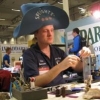
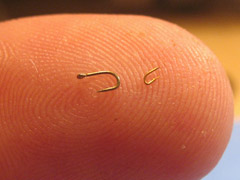
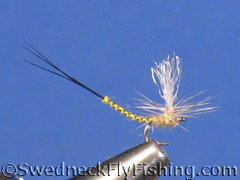
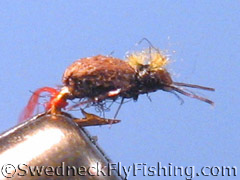
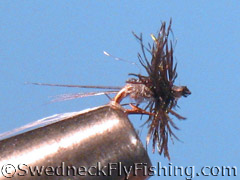
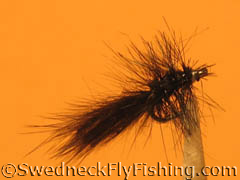
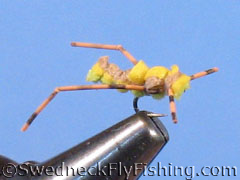


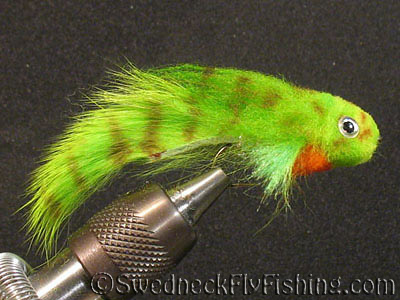








Whip Finishers
in The Fly Tying Bench
Posted · Report reply
Whip-finish at the back of the fly on stimulator hook (2X long) size #8, around wide foam strip and behind long hackle and rubber legs.
I didn't try any of my tools for it, but I'm still very sure that my fingers saved me a lot of time (and effort) when doing it.
"Much faster", "more precise" and "hardly an expense"... but in some situations the tool just isn't enough.
Don's "Megarelli" maybe would be something though. Wider range than most WF-tools (incl. fingers)... and much(!) easier to find on the bench.
This was sent to Frank Matarelli for his induction to the Fly-Tyers Hall of Fame and he had it lying on his podium there. He loved it and
apparently Don had a heck of a time getting him to send it back... so obviously a perfectly fine knock-off also to Mr Frank.